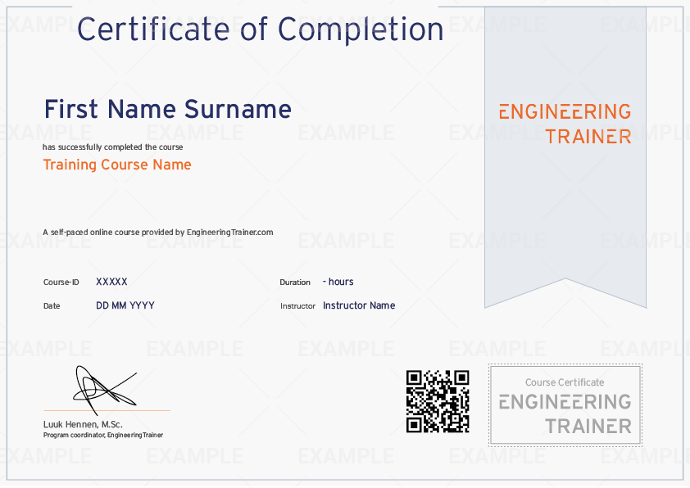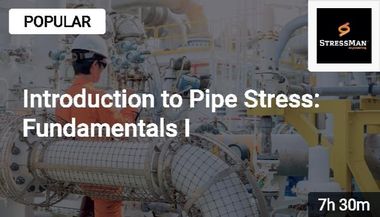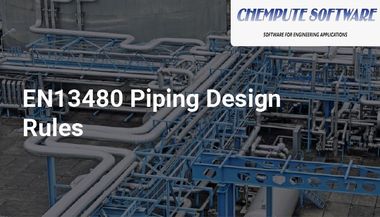Practical Guide to Plant Layout
Self-paced Course
3 Modules
Mike Lureman
SPC2101
Format:
On-demand
€96 For Teams
Get a 20% discount on all courses for you and your team.
Free Course Preview
Help yourself with your purchasing decision. Watch free content now.
Course Objective
"To provide an understanding of the considerations that come with laying out a plant and to show how to design a simple plant layout."
Learn from home
100% online training
Video Lectures by Experts
watch multiple times
Available 24/7
1-year unlimited access
PDH Hours qualified course
Read more here
About the course
Self-paced
3 modules
1:30 hr
English
1-year access
SPC2101
Plant layouts have a major influence on the operation of a plant. An improper layout design can lead to hazardous situations, impractical maintenance or reduced plant efficiency. These can have a significant financial impact for the owner of the plant. So understanding the various considerations that come with determining a plant layout is important for designing a proper layout.
In this course different considerations are discussed for different levels of layout design and applications. This will increase your understanding of what has to be taken into account when designing a plant layout. Topics include safety, proximity, maintenance, constructibility, practicality and economic considerations. After this course participants will have the knowledge to design a basic plant layout.
This course contains 3 online modules based on video content and exercises. An extensive case is included in the course, for which the solution is explained by the instructor.
You receive 1-year unlimited access to the course. This allows you to perform modules again, should you need to refresh your knowledge for your work projects.
Questions? Contact us
hello@engineeringtrainer.com
+31 (0)85 058 0051
Monday - Friday, 9am - 6pm CEST

Meet your instructor
Program & Details
Welcome to the course
Your instructor
How to use this course
Personal Certificate requirements
Layout Development Objective and Development Team
Definition of Key Layout Deliverables
A sample of the first module is available for free, so you can learn more about the teaching style and understand if the course fits your needs.
Site Master Plan Considerations
Plot Plan Considerations
Example of Equipment Arrangement
Plant Layout General Considerations
Introduction
Quick Questions
Considerations
Plant Layout Exercise
Explanation
Congratulations
Course evaluation survey
Your Personal Certificate
Rate this course
Related resources & followup
Results
After this course, you...
have a good overview of the plant layout considerations
are able to design a basic plant layout
can identify the potential hazards on a plant and incorporate them in your layout design
understand what information is required to design different layouts
have an overview of which personnel and stakeholders are involved during the plant layout design phase
Who should attend this course
Beginner and intermediate plant layout designers
People involved in plant design and site selection
Plant process designers that want to know the impact of their designs on the plant layout
Prerequisites:
Affinity with industrial plants
Level: Introduction
Access to the course.
After your purchase is confirmed you receive an account to the EngineeringTrainer online learning portal, where you find the course in your dashboard. After opening the course you will be guided step-by-step through the different modules. You receive 1-year unlimited access to the course. This allows you to perform modules again if this is beneficial for your work projects.
Learn by doing.
The course is based on video content and a case study. Both the videos and case study can be viewed as many times as desired. The video lectures help you to grasp the important technical concepts. In the case study you will have the chance to put your freshly gained knowledge to work and the answers to the case questions are explained in instruction videos.
This course is self-paced and is not subject to specific dates. The course contains a total of 1.5 hours of content which can be performed at your own pace. A Personal Certificate will be provided to you if you finish the course within the first month after purchase. This incentive will motivate you to perform the course quickly thereby improving your learning curve.
You receive 1-year unlimited access to all content. This allows you to perform modules again whenever you want to refresh knowledge for your daily work projects.
A personal digital certificate will be made available to each participant upon full attendance.
Example Certificate:

FAQ
Video lectures
Video case instructions & explainer videos
Case solution video
The majority of training material are videos. These are not available for download, but can be accessed directly with your account on the portal. Apart from quizzes the exercise files can be downloaded. These can include .pdf files with the exercise questions, excel files or other file types.
You receive 1-year unlimited access to the course. This allows you to watch content again if this is beneficial for your work projects.
We encourage participants to submit feedback and questions. These form the basis for new, future videos that will be added to the online course, but they will not be answered to the student directly.
Participants receive 1-year unlimited access to the course including new videos that are added during this year. Participants receive an email notification upon addition of new content.
No technical software is used in this course.
If your computer and internet connection are able to play videos on YouTube you will be able to participate in this course. The case study is partially based on pdf files which you should be able to open.
Note that almost all browsers are supported, except for Internet Explorer.
Yes, this course qualifies for PDH hours as per the NCEES CPC Guidelines.
Program & Details
Course Welcome
-
Welcome to the course
-
Your instructor
-
How to use this course
-
Personal Certificate requirements
Module 1: Valve Fundamentals
-
The purpose of using and actuated valve
-
Describing the application
-
Actuated on/off valves
-
Control valves
-
Self-actuating regulators
Module 2: Operation and Maintenance
-
Criticality
-
Lifecycle conditions
-
Maintainability
-
Maintenance strategies
-
Operational safely
-
Leak detection and repair
-
Failure Modes
Module 3: Overview of Valve Styles
-
The 2 fundamental construction types
-
Rotary motion valves
-
Linear motion valves
-
Variations
Module 4: Requistioning
-
Data/requisition sheet
-
Common aspects
-
Ingress protection
-
Electromagnetic compatibility
-
Hazardous areas
-
Type acceptance training
-
Inspection and test plan (ITP)
-
CE marking
Module 5: Actuated Valve Manufacturing
-
QA/ QC
-
Inspection and testing
-
Documentation
-
Painting
-
Acceptance testing
Final Notes
-
Congratulations
-
Course evaluation survey
-
Your Personal Certificate
-
Welcome to the course
-
Your instructor
-
How to use this course
-
Personal Certificate requirements
-
The purpose of using and actuated valve
-
Describing the application
-
Actuated on/off valves
-
Control valves
-
Self-actuating regulators
-
Criticality
-
Lifecycle conditions
-
Maintainability
-
Maintenance strategies
-
Operational safely
-
Leak detection and repair
-
Failure Modes
-
The 2 fundamental construction types
-
Rotary motion valves
-
Linear motion valves
-
Variations
-
Data/requisition sheet
-
Common aspects
-
Ingress protection
-
Electromagnetic compatibility
-
Hazardous areas
-
Type acceptance training
-
Inspection and test plan (ITP)
-
CE marking
-
QA/ QC
-
Inspection and testing
-
Documentation
-
Painting
-
Acceptance testing
-
Congratulations
-
Course evaluation survey
-
Your Personal Certificate







